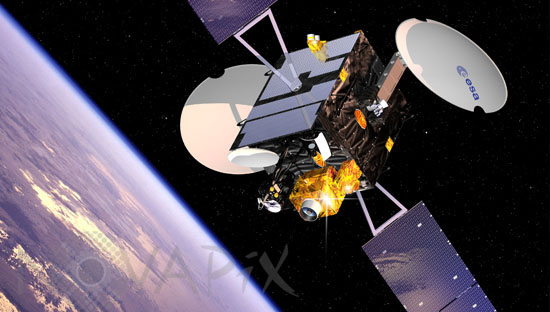Photo Agency - Astronomy - Space - Nature

Communication satellite Artemis. Artwork
auteur: ESA/J.Huart/Novapix
référence: e-sco01-10202
Image Size 300 DPI: 25 * 14 cm
Built by ESA with an industrial team led by Italy's Alenia Spazio, Artemis carries three payloads plus a number of experiments developed to demonstrate new telecommunications technologies.
The L-band Land Mobile (LLM) payload provides relay for two-way voice and data communications between fixed Earth stations and land mobiles - trucks, trains or cars - anywhere in Europe and North Africa. LLM is also broadcasting corrective GPS-like navigation signals for the European Global Navigation Overlay Service (EGNOS) programme, Europe's first satellite navigation system and a forerunner to the Galileo global navigation system.
The other two primary payloads are designed to provide direct high data rate communications links between satellites and with ground stations in Europe. The Semiconductor laser Inter-satellite Link EXperiment (SILEX) sends and receives data over a laser beam through an optical terminal equipped with a telescope. It has successfully been used with other terminals onboard France's Spot 4 remote sensing satellite or at a ground-based observatory on the Pico de Teide, in Tenerife, Canary Islands. The S/Ka-band Data Relay (SKDR) terminal provides high data rate communication links with low Earth orbiting satellites like Envisat, and will be used for communications with the Columbus laboratory onboard the International Space Station (ISS).
The 3,106-kg Artemis was launched on July 12, 2001, atop an Ariane 5G vehicle (V142) from the Guiana Space Centre, Europe's space port, in French Guiana. An anomaly during the upper stage burn resulted in a performance shortfall and Artemis had to use its onboard propellant and experimental ion thrusters to reach its final geostationary orbit. It eventually arrived on station by January 2003.
Contact : Stéphane Aubin +33-(0)9-51-26-53-76
© Novapix - All rights reserved






